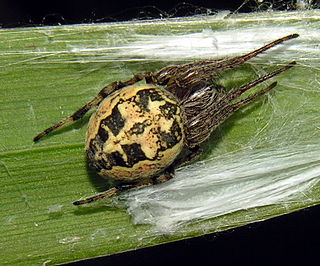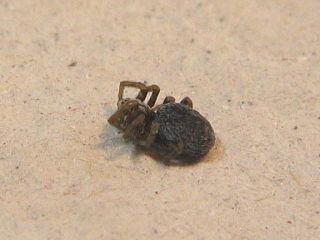Afrobeata is a genus of jumping spiders that was first described by Lodovico di Caporiacco in 1941. As of August 2022 it contains only three species, found only in Tanzania, Ethiopia, and on Socotra: A. firma, A. latithorax, and A. magnifica. The name is derived from "Africa" and the genus Beata.
Dolichoneon is a monotypic genus of jumping spiders containing the single species, Dolichoneon typicus. It was first described by Lodovico di Caporiacco in 1935, and is only found in Karakorum. Its taxonomic relationships within the family Salticidae are uncertain.
Platypsecas is a monotypic genus of Venezuelan jumping spiders containing the single species, Platypsecas razzabonii. It was first described by Lodovico di Caporiacco in 1955, and is only found in Venezuela. The type locality is El Junquito in the Capital District. Gustavo R. S. Ruiz and Antonio D. Brescovit though the genus was "possibly in Euophryinae"; Wayne P. Maddison followed their "tentative suggestion" and classified the genus in the tribe Euophryini within the clade Saltafresia and subfamily Salticinae.
Pseudamphidraus is an obsolete spider genus of the jumping spider family, Salticidae. Both described species have only been found in Guyana. The genus was erected by Ludovico di Caporiacco in 1947.
Tomis is a genus of South American jumping spiders that was first described by F.O. Pickard-Cambridge in 1901. The genus Pseudattulus, erected by Lodovico di Caporiacco in 1947, was formerly considered distinct with two species, but was placed in synonymy in 2020 when Tomis was re-separated from Sitticus.
Pseudocorythalia is a monotypic genus of Guatemalan jumping spiders containing the single species, Pseudocorythalia subinermis. It was first described by Lodovico di Caporiacco in 1938, and is found only in Guatemala. The name is a combination of the Ancient Greek "pseudo-" (ψευδής), meaning "false", and the salticid genus name Corythalia.
Vatovia is a monotypic genus of Ethiopian jumping spiders containing the single species, Vatovia albosignata. It was first described by Lodovico di Caporiacco in 1940, and is found in Ethiopia. Its taxonomic relationships within the family Salticidae are uncertain.

Larinioides is a genus of orb-weaver spiders commonly known as flying spiders and first described by Lodovico di Caporiacco in 1934. They mostly occur in temperate climates around the northern hemisphere. The name is derived from the related araneid spider genus Larinia, with the meaning "like Larinia".

Archaeodictyna is a genus of cribellate araneomorph spiders in the family Dictynidae, and was first described by Lodovico di Caporiacco in 1928.
Zangherella is a genus of araneomorph spiders in the family Anapidae, first described by Lodovico di Caporiacco in 1949.As of April 2019 it contains only three species.
Arushina is a monotypic genus of East African corinnid sac spiders containing the single species, Arushina dentichelis. It was first described by Lodovico di Caporiacco in 1947, and has only been found in Tanzania. Originally placed with the Dictynidae, it was moved to the Ant spiders in 1967, to the Sac spiders in 1991, then to the Corrinid sac spiders in 2000.
Scorteccia is a monotypic genus of North African corinnid sac spiders containing the single species, Scorteccia termitarum. It was first described by Lodovico di Caporiacco in 1936, and has only been found in Libya.
Pseudosparianthis is a genus of huntsman spiders that was first described by Eugène Louis Simon in 1887.
Pseudodrassus is a genus of ground spiders that was first described by Lodovico di Caporiacco in 1935.
Scotocesonia is a monotypic genus of South American ground spiders containing the single species, Scotocesonia demerarae. It was first described by Lodovico di Caporiacco in 1947, and has only been found in Guyana.
Haedanula is a monotypic genus of African crab spiders containing the single species, Haedanula subinermis. It was first described by Lodovico di Caporiacco in 1941, and is found in Ethiopia.
Heriaesynaema is a monotypic genus of African crab spiders containing the single species, Heriaesynaema flavipes. It was first described by Lodovico di Caporiacco in 1939, and is found in Ethiopia.
Hexommulocymus is a monotypic genus of South American crab spiders containing the single species, Hexommulocymus kolosvaryi. It was first described by Lodovico di Caporiacco in 1955, and is found in Venezuela.

Aelurillus subaffinis is a species of jumping spider in the genus Aelurillus that lives in East Africa. It was first described in 1947 by Ludovico di Caporiacco based on a specimen that may have come from Tanzania. Only the female has been described. The spider is small. It has a dark brown carapace that is between 3.1 and 3.2 mm long and a yellow abdomen that has a length between 2.75 and 3.8 mm. It has brown chelicerae, a brown-yellow clypeus and yellow legs. The epigyne has a low pocket, distinctive shape and sclerotized flaps. It is similar to the related Aelurillus aeruginosus apart from the copulatory organs.
Firmicus is a genus of crab spiders that was first described by Eugène Louis Simon in 1895.


